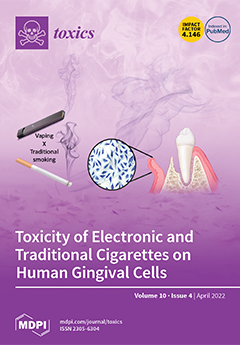尿液中多环芳香烃代谢物对血脂谱的影响:氧化应激是否起着关键的调解作用?
摘要
尿液中的多环芳烃(PAH)代谢物与氧化应激有关;然而,流行病学研究并未报道这些尿液中的多环芳烃代谢物对血脂水平的影响。本研究调查了尿液中多环芳烃代谢物、尿液中 8-羟基-2'-脱氧鸟苷(8-OHdG)与血脂之间的关系。研究共招募了 109 名老年志愿者,并提供了完整的数据集进行分析。2011 年冬季采集了血液和晨尿样本。尿液样本中的多环芳烃代谢物、肌酐和 8-OHdG 含量分别采用气相色谱-质谱法、分光光度法和酶联免疫吸附试剂盒进行分析。使用自动生化分析仪分析了血脂概况。采用双独立样本非参数检验评估了血脂谱与 8-OHdG 之间的关系,并按性别、吸烟和饮酒状况进行了分类。在对浓度值进行归一化处理后,采用一般线性回归模型来研究多环芳烃代谢物、8-OHdG 和血脂特征之间的相关性。建立了一个中介模型,以研究 8-OHdG 对 PAH 代谢物和血脂特征之间关系的中介作用。尿样中八种多环芳烃代谢物浓度的中位数在 1 至 10 μmol/mol 肌酐(Cr)之间。不同性别的人在血脂方面存在显著差异。然而,在吸烟或饮酒状况方面,两性之间没有发现明显差异。2-hydroxyfluorene (2-OHFlu)、1-hydroxypyrene (1-OHPyr)和 6-hydroxychrysene (6-OHChr)与尿液中 8-OHdG 水平的升高有关。具体而言,1-羟基萘(1-OHNap)和 1-OHPyr 与载脂蛋白 A1(载脂蛋白 A1)呈负相关。相反,1-OHPyr 与低密度脂蛋白胆固醇(LDL-C)呈正相关。此外,b,c-二羟基菲(2-OHBcPhe)与载脂蛋白 B(载脂蛋白 B)呈正相关。值得注意的是,8-OHdG 与血脂谱没有明显的相关性。8-OHdG 对羟化 PAHs 与血脂特征之间关系的中介效应在统计学上并不显著。然而,羟化 PAHs 对血脂的间接影响在统计学上是巨大的,特别是 1-OHNap 与载脂蛋白 A1 的关系(-0.025,95% CI:-0.041,-0.009)、1-OHPyr 与 LDL-C 的关系(0.107,95% CI:0.011,0.203)以及 2-OHBcPhe 与载脂蛋白 B 的关系(0.070,95% CI:0.005,0.135)。这项研究表明,尿 PAH 代谢物的增加可能会使尿 8-OHdG 水平升高,并影响血脂状况。然而,8-OHdG 与血脂之间没有直接关系。中介分析表明,多环芳烃代谢物对血脂变化的影响可能是通过氧化应激以外的途径产生的。Urinary polycyclic aromatic hydrocarbon (PAH) metabolites are associated with oxidative stress; however, epidemiological studies have not reported the impacts of these urinary PAH metabolites on blood lipid levels. This study investigated the relationship between urinary PAH metabolites, urinary 8-hydroxy-2'-deoxyguanosine (8-OHdG), and blood lipid profiles. A total of 109 elderly volunteers were recruited with complete datasets for analysis. Blood and morning urine samples were collected in the winter of 2011. The PAH metabolites, creatinine, and 8-OHdG levels in urine samples were analyzed using Gas Chromatography-Mass Spectrometry, spectrophotometry, and an ELISA kit, respectively. The blood lipid profiles were analyzed using an automatic biochemical analyzer. The relationship between lipid profiles and 8-OHdG was assessed using a two-independent sample nonparametric test, categorized by gender, smoking, and alcohol consumption status. After normalizing the concentration values, a general linear regression model was employed to examine the correlations between PAH metabolites, 8-OHdG, and lipid profiles. A mediation model was developed to investigate the mediating effect of 8-OHdG on the relationship between PAH metabolites and lipid profiles. The median of eight PAH metabolite concentrations in urine samples ranged from 1 to 10 μmol/mol creatinine (Cr). Significant differences in lipid profiles were observed across genders. However, no significant differences were found in smoking or alcohol consumption status for both genders. Linear regression analysis revealed that an increase in the logarithmic concentration of 2-hydroxynaphthalene (2-OHNap), 9-hydroxyfluorene (9-OHFlu), 3-hydroxyfluorene (3-OHFlu), 2-hydroxyfluorene (2-OHFlu), 1-hydroxypyrene (1-OHPyr), and 6-hydroxychrysene (6-OHChr) was associated with an increase in urinary 8-OHdG levels, after adjusting for BMI and age. Specifically, 1-hydroxynaphthalene (1-OHNap) and 1-OHPyr correlated negatively with apolipoprotein A1 (Apo A1). Conversely, 1-OHPyr was positively correlated with low-density lipoprotein cholesterol (LDL-C). In addition, b,c-dihydroxyphenanthrene (2-OHBcPhe) was positively associated with apolipoprotein B (Apo B). Notably, 8-OHdG did not exhibit a significant correlation with lipid profiles. The mediating effect of 8-OHdG on the relationship between hydroxylated PAHs and lipid profiles was not statistically significant. However, the indirect effects of hydroxylated PAHs on blood lipids were statistically substantial, specifically for 1-OHNap to Apo A1 (-0.025, 95% CI: -0.041, -0.009), 1-OHPyr to LDL-C (0.107, 95% CI: 0.011, 0.203), and 2-OHBcPhe to Apo B (0.070, 95% CI: 0.005, 0.135). This study suggests that an increase in urinary PAH metabolites may elevate the levels of urinary 8-OHdG and influence blood lipid profiles. However, no direct relationship was found between 8-OHdG and lipid profiles. The mediation analysis indicated that the effects of PAH metabolites on lipid changes may operate through pathways other than oxidative stress.

 求助内容:
求助内容: 应助结果提醒方式:
应助结果提醒方式:


